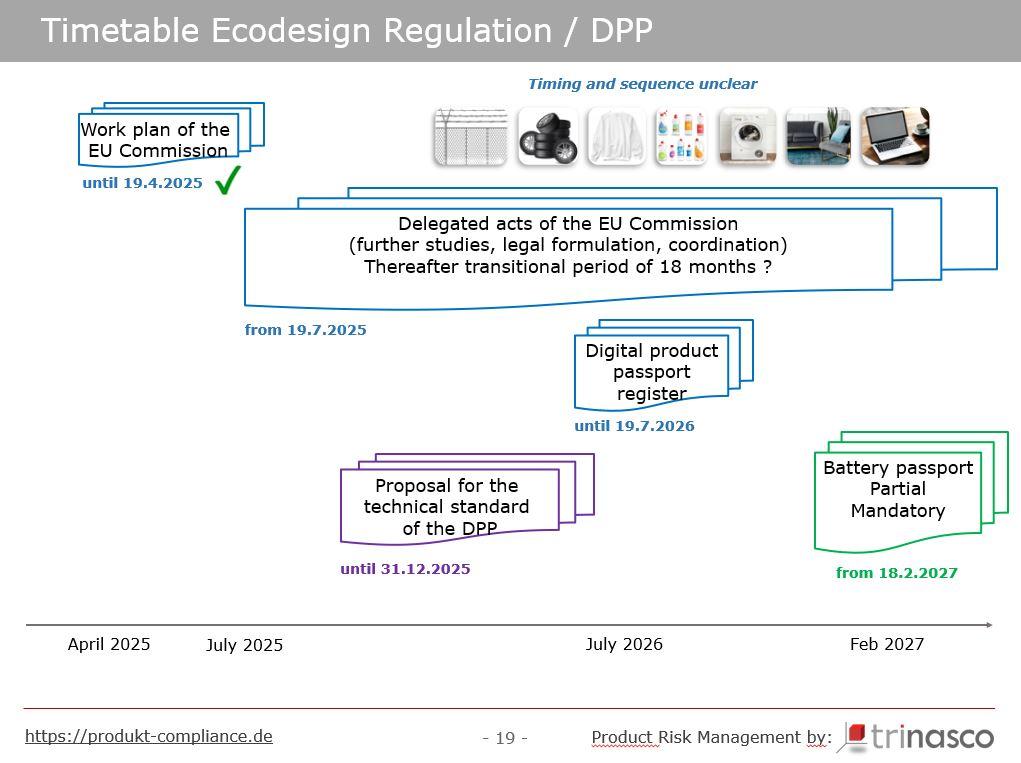The Digital Product Passport (DPP) is one of the most ambitious projects under the European Green Deal. Its goal is to provide environmental and sustainability data in a central digital format across the entire product life cycle. What may seem like a bureaucratic obligation is in fact a major step toward sustainable business and the circular economy.
Manufacturers, importers and retailers are now tasked with providing structured data that either did not previously exist or was not maintained in a structured format. At the same time, the DPP opens up new opportunities for efficiency gains, service innovations and transparent customer communication. This article, based on a lecture series by trinasco GmbH, summarizes the key developments and provides practical recommendations.
The DPP is a structured dataset that collects digital information about a product – from materials used and hazardous substances to repair instructions. It accompanies the product throughout its life cycle and is intended to support companies, consumers and recyclers in making informed and sustainable decisions.
The DPP therefore serves as an interface between regulatory requirements, technical documentation, and market communication. The aim is to create standardized formats to facilitate efficient data exchange throughout the supply chain and promote the circular economy.
In addition to fulfilling regulatory requirements, the DPP offers many business benefits. Centralized access to product data improves communication with suppliers and customers, reduces effort during product recalls, and increases transparency about material use, energy consumption and reparability. It also opens up new digital business models such as cross-selling, after-sales services or customized repair offerings.
The DPP is introduced and supported by multiple EU regulations. The cornerstone is the Ecodesign Regulation (EU) 2024/1781, which came into force in July 2024. It defines the framework for product-related requirements, which will be specified in delegated acts. Other relevant regulations include the Battery Regulation (EU) 2023/1542, the Construction Products Regulation (EU) 2024/3110, and the draft Toy Safety Regulation.

Figure 1: Overview of EU regulations relevant to the DPP
Starting in July 2025, the European Commission will publish the first delegated acts. The DPP will then gradually become mandatory for prioritized product groups. A digital product passport register is scheduled to be available from July 2026.

Figure 2: DPP implementation timeline according to the Ecodesign Regulation
The DPP will contain extensive information, including technical data, labels, conformity documents, material and substance information, carbon footprints, and repairability data. All information must be machine-readable and structured to enable automated processing.
A key reference is the report by the Joint Research Centre (JRC) of the European Commission. This 388-page document identifies prioritized product categories and suggests criteria to be included in the DPP – such as energy and resource efficiency, reparability, recyclability, and transparency on hazardous substances. Particularly affected sectors include textiles, furniture, electronics, chemicals, and materials such as steel and aluminum.

Figure 3: Examples of potential ecodesign requirements for furniture (JRC report)
In April 2025, the European Commission published the first work plan for implementing the Ecodesign Regulation. While based on the JRC findings, it differs in some aspects. Product groups such as detergents, paints, lubricants, footwear and chemicals, originally given high priority in the JRC report, are not yet included in the official work plan. Instead, the EU focuses on furniture, textiles, electronics, tyres, lubricants, and detergents. The Commission emphasizes that the work plan will be updated regularly, and companies from affected sectors should closely monitor further developments.

Figure 4: Prioritization of product groups in the EU Commission’s work plan (April 2025)
There is no universal standard for the DPP yet. Various standardization bodies across Europe are working on access rights, interoperability, data storage and data persistence. In Germany, the Deutsches Institut für Normung (DIN) plays a leading role and published first proposals in June 2025 for secure and standardized data exchange protocols.

Figure 5: Standardization initiatives at EU and national level
Besides DIN, international organizations like GS1 are also involved. Initial pilot projects already exist – including digital twins in mechanical engineering and RFID tags in textiles. QR codes, digital labels, and web portals are expected to play a central role in future implementations.

Figure 6: DIN draft for data exchange protocols (June 2025)
Companies should start preparing for the DPP today. The first step is to set up a cross-functional project team covering technical, regulatory, and process aspects. This should be followed by an audit of existing product data and systems. Early dialogue with suppliers and customers is crucial to identify relevant data points. It’s also essential to stay updated on industry initiatives, standardization activities, and EU publications.
The Digital Product Passport is no longer a distant vision – it’s becoming reality. Companies that act early can not only reduce risks but also gain competitive advantages. trinasco supports companies on this path – with expertise, networks, and tailored consulting services.
What do you need to do now? Book our free initial consultation now.
Save €249!!
What do you need to do now? Book our free initial consultation now.
Save €249!!